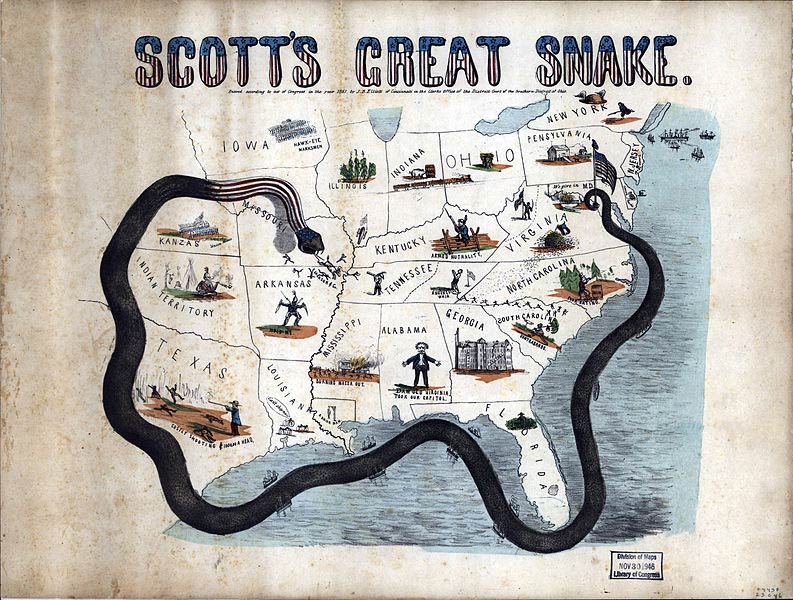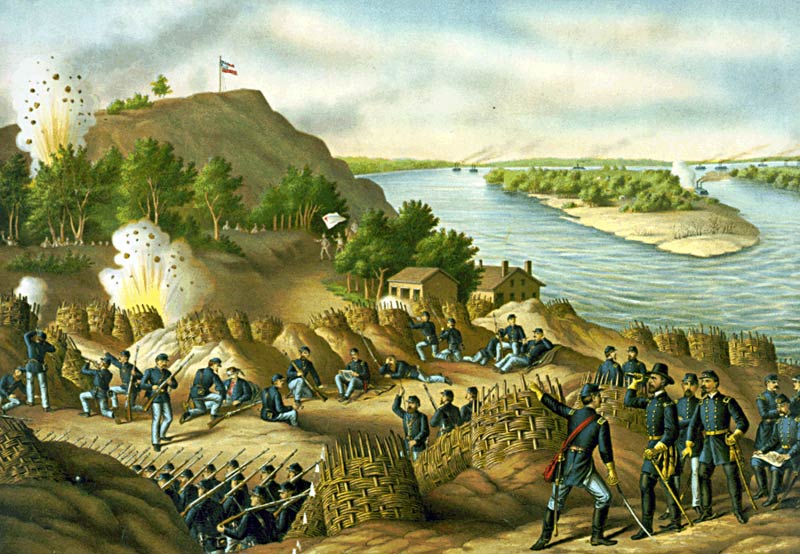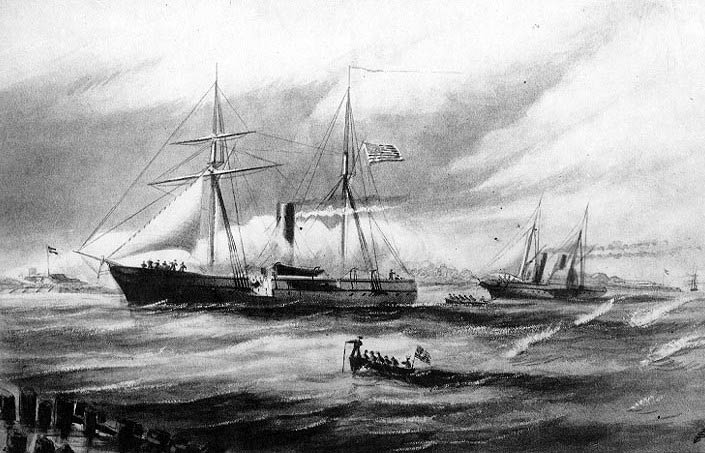 The Anaconda Plan was the popular name given to a strategy employed by the Union during the American Civil War. It consisted of a large-scale blockade of ports in the South, combined with a Federal attack along the Mississippi River, aimed at splitting the Confederacy. The plan was suggested by Winfield Scott, General-in-Chief of the U.S. Army. It received the name because of its relative passivity: the image conjured up was one of an anaconda slowly squeezing the life from its victim.
The Anaconda Plan was the popular name given to a strategy employed by the Union during the American Civil War. It consisted of a large-scale blockade of ports in the South, combined with a Federal attack along the Mississippi River, aimed at splitting the Confederacy. The plan was suggested by Winfield Scott, General-in-Chief of the U.S. Army. It received the name because of its relative passivity: the image conjured up was one of an anaconda slowly squeezing the life from its victim.
Birth of the Anaconda Plan
Scott was the first man to draw up a military strategy to put down the uprising in the Southern states. As early as the beginning of April 1861, he had regular meetings with President Abraham Lincoln, in which he offered his thoughts on the current situation. The briefings he gave resulted in refinement of the military objectives to which the Union would aspire. In the first week of May, Scott informed Major General George B. McClellan that he felt a properly enforced blockade of Confederate-held ports, together with an advance along the Mississippi, would allow the establishment of Federal positions and leave the Confederacy disorganized, isolated, and with no alternative but to agree to terms.
In a foreshadowing of its later name, McClellan likened Scott’s plan to a boa constrictor. Scott took his ideas to Lincoln, and explained in more detail exactly what he proposed should be done. He suggested that a force of 60,000 men, accompanied by gunboats, should pass along the Mississippi to make it secure for Union in a line from the Illinois city of Cairo to the Gulf of Mexico. Together with the blockade, he felt that this would be sufficient to isolate the South. At this point, thought Scott, those in the South who agreed with the Union (of whom he believed there were many more than had stated their positions publicly) would force their governors to agree to surrender.
Scott was, however, mistaken: diplomacy was not what the South wanted. It was agitating for battle. The idea of simply constricting the South to the point of surrender, rather than forcing it by force of arms proved deeply unpopular in the press, and McClellan’s earlier remark was picked up by several newspapers, as the “Anaconda Plan” name became widely used. Nevertheless, the plan was accepted after some hesitation by the Union command. It was put into action in 1862, and consisted of several parts.
The Objectives
First, the South would be divided by the United States gaining control of the Mississippi – and thereby cutting it off from the West. This was eventually to prove highly significant in the outcome of the war, and Confederate President Jefferson Davis referred to Vicksburg as being his nation’s “vital point.” Even though the population was more thinly spread here than around the cities of the Eastern Theater, the river was nevertheless of enormous strategic importance. If the Union succeeded in its intention to capture it, then it would allow men and arms to be transported with much greater ease to the South. The Vicksburg campaign, won by Major General Ulysses S. Grant, did indeed achieve this aim and from that point onward, the Confederacy was fighting a losing battle in many respects.
Another important aspect of the plan was to capture the valley of the Tennessee River. The city of Nashville was served by no fewer than five railroads, while as well as the Tennessee River itself, the state also played host to the Cumberland River. There was also a major ironworks at Clarksville, on the border of the state with Kentucky. Tennessee was therefore an important center for the distribution and marshaling of resources, and Nashville quickly became a major holding point for supply and arms stockpiles. Two forts, Fort Donelson and Fort Henry, were constructed to defend the area – but Grant captured Fort Donelson in February 1862, after which Southern commander General Albert Sidney Johnston, realizing that his position was impossible, drew back from Nashville. The depot passed into Federal control, where it remained for the rest of the war, providing the Union with another crushing advantage.
The presence of the blockade was also intended to be instrumental in stopping the Confederacy from trading with the outside world, in either direction. The South needed to import raw materials in order to prosecute the war, especially after the loss of the stockpiles at Nashville. Similarly, the crippling cost of the war had to be met from somewhere, and the South’s main means of raising money were through the export of cash crops such as tobacco and cotton. The fact that these plants were largely grown in plantations worked by slave labor was not lost on the combatants.
The final aim of the plan was that the Confederate capital of Richmond, Virginia, would be overrun by United States forces. However, this was in fact the least successful part of the strategy, as the city was not occupied by a Federal army until April 1865, when Grant’s men succeeded in taking the city. By that time, the war was drawing to a close; indeed, General Robert E. Lee would surrender his own army a matter of days later. Although the capture of Richmond did have some morale-boosting value, by spring 1865, it was of minor significance militarily.
Aftermath
It was the Western Theater of the American Civil War that proved to be the most important region in the final defeat of the Confederacy, and this area was also that which was most significant to the Anaconda Plan itself. The successful campaign by the Union to take control of the Tennessee Valley and Mississippi River greatly exacerbated the mismatch in resource levels between the two sides; without the plan, they would have been fighting on considerably more equal terms.
Grant himself showed by his victories during this period that he was a highly able commander, and a man who had the ability – as Lincoln later recognized – to command the Union forces in their entirety. For the South’s part, if Lee had retained the resources the blockade lost him, he would have been able to continue fighting for much longer, hoping to force an exhausted Union to come to terms. As such, despite the Anaconda Plan’s undramatic nature, it in fact shortened the war considerably.

